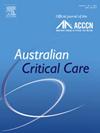A survey of healthcare providers about the feasibility and implementation of early mobilisation of patients in critical care units in a Lebanese hospital
IF 2.6
3区 医学
Q2 CRITICAL CARE MEDICINE
引用次数: 0
Abstract
Background
Many survivors of critical care experience complications from bed rest after recovering from the acute phase. Early mobilisation helps patients recover faster. However, anecdotal evidence suggests that patients in critical care units are rarely mobilised.
Aim
The aims of the study were to assess the feasibility of early mobilisation of patients in intensive care units from the clinicians' perspective in a Lebanese hospital during the COVID-19 pandemic, identify associated institutional factors, and describe the knowledge, attitude, practices, and perceived barriers to early mobilisation among Lebanese clinicians.
Methods
A descriptive correlational design was used. Forty-nine healthcare providers (response rate: 41%) who work in critical care at a tertiary medical centre in Lebanon were recruited. Data were collected online via LimeSurvey using the Modified Mobility Survey Questionnaire. Descriptive statistics, bivariate correlations, and hierarchical multiple linear regression were used.
Results
Most respondents were nurses, and also included two physicians, four physiotherapists, and four respiratory therapists. Most respondents (67%) perceived early mobility to be crucial or very important, but only 33% thought its implementation was feasible. Many patient, provider, and institutional barriers to implementation were identified. Most clinicians thought that mobility must be started early, but 60% reported lack of training in mobilisation and identified patient instability, safety concerns, and lack of guidelines as barriers. Lack of equipment (unstandardised regression coefficient B = −0.87, 95% confidence interval = −1.7, −0.05; p = 0.039) and lack of guidelines (B = −0.67, 95% confidence interval = −1.37, 0.04; p = 0.063) were associated with lower feasibility of implementing early mobility in the multivariable analysis.
Conclusion
Despite appreciating benefits of early mobility, the respondents identified many barriers to its implementation. The findings suggest the need for staff education and training in early mobility and development of a multidisciplinary protocol on mobilisation. In addition, the needed human and physical resources ought to be assessed.
一项关于黎巴嫩一家医院重症监护病房病人早期动员的可行性和实施情况的保健提供者调查。
背景:许多重症监护幸存者从急性期恢复后,卧床休息会出现并发症。早期动员有助于患者更快康复。然而,轶事证据表明,重症监护病房的病人很少被动员起来。目的:本研究的目的是从临床医生的角度评估2019冠状病毒病大流行期间黎巴嫩医院重症监护病房患者早期动员的可行性,确定相关的制度因素,并描述黎巴嫩临床医生早期动员的知识、态度、做法和感知障碍。方法:采用描述性相关设计。招募了49名在黎巴嫩三级医疗中心从事重症护理工作的保健提供者(答复率:41%)。数据通过limessurvey在线收集,使用改进的流动性调查问卷。使用描述性统计、双变量相关和层次多元线性回归。结果:受访人员以护士为主,另有2名内科医生、4名物理治疗师和4名呼吸治疗师。大多数受访者(67%)认为早期流动性至关重要或非常重要,但只有33%的人认为其实施是可行的。确定了实施的许多患者、提供者和机构障碍。大多数临床医生认为必须尽早开始行动,但60%的医生报告缺乏行动方面的培训,并认为患者不稳定、安全问题和缺乏指南是障碍。设备缺乏(未标准化回归系数B = -0.87, 95%置信区间= -1.7,-0.05;p = 0.039)和缺乏指南(B = -0.67, 95%可信区间= -1.37,0.04;P = 0.063)与多变量分析中实施早期流动性的可行性较低相关。结论:尽管认识到早期流动性的好处,但受访者确定了实施的许多障碍。调查结果表明,需要对工作人员进行早期调动方面的教育和培训,并制定关于调动的多学科议定书。此外,还应评估所需的人力和物质资源。
本文章由计算机程序翻译,如有差异,请以英文原文为准。
求助全文
约1分钟内获得全文
求助全文
来源期刊

Australian Critical Care
NURSING-NURSING
CiteScore
4.90
自引率
9.10%
发文量
148
审稿时长
>12 weeks
期刊介绍:
Australian Critical Care is the official journal of the Australian College of Critical Care Nurses (ACCCN). It is a bi-monthly peer-reviewed journal, providing clinically relevant research, reviews and articles of interest to the critical care community. Australian Critical Care publishes peer-reviewed scholarly papers that report research findings, research-based reviews, discussion papers and commentaries which are of interest to an international readership of critical care practitioners, educators, administrators and researchers. Interprofessional articles are welcomed.
 求助内容:
求助内容: 应助结果提醒方式:
应助结果提醒方式:


